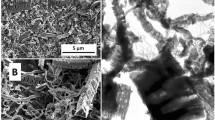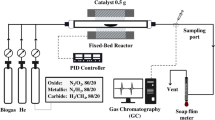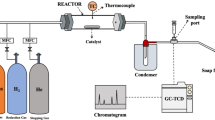Abstract
Carbon dioxide (CO2) fixation into value-added solid carbon such as carbon nanofibres (CNF) for longer-term storage represents a promising avenue for achieving net-negative carbon emissions. However, directly converting CO2 to CNF via thermocatalytic approaches faces thermodynamic constraints, while electrocatalytic methods typically lead to amorphous carbon with limited yields or require energy-intensive conditions (>720 °C). Here, we present an electrocatalytic–thermocatalytic tandem strategy for CNF production, which circumvents the aforementioned thermodynamic limitations by integrating the co-electrolysis of CO2 and water into syngas (CO and H2) with a subsequent thermochemical process at relatively mild conditions (370–450 °C, 1 atm), yielding CNF at a high production rate (average 2.5 gcarbon gmetals−1 h−1). The optimal coordinated actions of FeCo alloy and extra metallic Co were ascertained to enhance the dissociative activation of syngas and favour the carbon–carbon bond formation to produce CNF. This tandem strategy opens a door to leverage renewable energy for decarbonizing CO2 into valuable solid carbon products while producing renewable H2.

This is a preview of subscription content, access via your institution
Access options
Access Nature and 54 other Nature Portfolio journals
Get Nature+, our best-value online-access subscription
$29.99 / 30 days
cancel any time
Subscribe to this journal
Receive 12 digital issues and online access to articles
$119.00 per year
only $9.92 per issue
Buy this article
- Purchase on Springer Link
- Instant access to full article PDF
Prices may be subject to local taxes which are calculated during checkout




Similar content being viewed by others
Data availability
The source data that support the findings of this study are available from the corresponding authors on reasonable request. Source data are provided with this paper.
References
Armstrong McKay, D. I. et al. Exceeding 1.5 °C global warming could trigger multiple climate tipping points. Science 377, eabn7950 (2022).
Matthews, H. D. & Wynes, S. Current global efforts are insufficient to limit warming to 1.5 °C. Science 376, 1404–1409 (2022).
Chen, S., Liu, J., Zhang, Q., Teng, F. & McLellan, B. C. A critical review on deployment planning and risk analysis of carbon capture, utilization, and storage (CCUS) toward carbon neutrality. Renew. Sust. Energ. Rev. 167, 112537 (2022).
Wang, D., Xie, Z., Porosoff, M. D. & Chen, J. G. Recent advances in carbon dioxide hydrogenation to produce olefins and aromatics. Chem 7, 2277–2311 (2021).
Jiang, X., Nie, X., Guo, X., Song, C. & Chen, J. G. Recent advances in carbon dioxide hydrogenation to methanol via heterogeneous catalysis. Chem. Rev. 120, 7984–8034 (2020).
Xie, Z. & Chen, J. G. Bimetallic-derived catalytic structures for CO2-assisted ethane activation. Acc. Chem. Res. https://doi.org/10.1021/acs.accounts.3c00348 (2023).
De Luna, P. et al. What would it take for renewably powered electrosynthesis to displace petrochemical processes? Science 364, eaav3506 (2019).
Ge, L. et al. Electrochemical CO2 reduction in membrane-electrode assemblies. Chem 8, 663–692 (2022).
She, X., Wang, Y., Xu, H., Chi Edman Tsang, S. & Ping Lau, S. Challenges and opportunities in electrocatalytic CO2 reduction to chemicals and fuels. Angew. Chem. Int. Ed. 61, e202211396 (2022).
Jin, J. et al. Constrained C2 adsorbate orientation enables CO-to-acetate electroreduction. Nature 617, 724–729 (2023).
Lin, H., Luo, S., Zhang, H. & Ye, J. Perspective toward solar-driven carbon recycling. Joule 6, 294–314 (2022).
Biswas, A. N. et al. Oxygenate production from plasma-activated reaction of CO2 and ethane. Am. Chem. Soc. Energy Lett. 7, 236–241 (2022).
George, A. et al. A review of non-thermal plasma technology: a novel solution for CO2 conversion and utilization. Renew. Sust. Energ. Rev. 135, 109702 (2021).
Wang, Q., Kalathil, S., Pornrungroj, C., Sahm, C. D. & Reisner, E. Bacteria–photocatalyst sheet for sustainable carbon dioxide utilization. Nat. Catal. 5, 633–641 (2022).
Schwarz, F. M., Moon, J., Oswald, F. & Müller, V. Biological hydrogen storage and release through multiple cycles of bi-directional hydrogenation of CO2 to formic acid in a single process unit. Joule 6, 1304–1319 (2022).
Biswas, A. N., Winter, L. R., Xie, Z. & Chen, J. G. Utilizing CO2 as a reactant for C3 oxygenate production via tandem reactions. J. Am. Chem. Soc. Au 3, 293–305 (2023).
Lee, M. G. et al. Selective synthesis of butane from carbon monoxide using cascade electrolysis and thermocatalysis at ambient conditions. Nat. Catal. 6, 310–318 (2023).
Anderson, K. & Peters, G. The trouble with negative emissions. Science 354, 182–183 (2016).
Biniek, K., Henderson, K., Rogers, M. & Santoni, G. Driving CO2 emissions to zero (and beyond) with carbon capture, use, and storage. McKinsey Quarterly (30 June, 2020).
Moon, S. & Prasad, Y. E., Global Carbon Nano Materials Market by Product Type: Global Opportunity Analysis and Industry Forecast, 2021–2031 (Allied Market Research, 2022).
Esrafilzadeh, D. et al. Room temperature CO2 reduction to solid carbon species on liquid metals featuring atomically thin ceria interfaces. Nat. Commun. 10, 865 (2019).
Zuraiqi, K. et al. Direct conversion of CO2 to solid carbon by Ga-based liquid metals. Energy Environ. Sci. 15, 595–600 (2022).
Ye, L. et al. Low‐temperature CO2 reduction using Mg–Ga liquid metal interface. Adv. Mater. Interfaces 10, 2201625 (2023).
Ren, J., Li, F.-F., Lau, J., González-Urbina, L. & Licht, S. One-pot synthesis of carbon nanofibers from CO2. Nano Lett. 15, 6142–6148 (2015).
Wu, H. et al. One-pot synthesis of nanostructured carbon materials from carbon dioxide via electrolysis in molten carbonate salts. Carbon 106, 208–217 (2016).
Ruiz-Cornejo, J. C., Sebastián, D. & Lázaro, M. J. Synthesis and applications of carbon nanofibers: a review. Rev. Chem. Eng. 36, 493–511 (2020).
Shi, T., Li, Z., Guo, J., Gong, H. & Gu, C. Research progress on CNTs/CNFs-modified cement-based composites—a review. Constr. Build. Mater. 202, 290–307 (2019).
Metaxa, Z. S., Konsta-Gdoutos, M. S. & Shah, S. P. Carbon nanofiber–reinforced cement-based materials. Transp. Res. Rec. 2142, 114–118 (2010).
Ilinova, A. & Kuznetsova, E. CC(U)S initiatives: prospects and economic efficiency in a circular economy. Energy Rep. 8, 1295–1301 (2022).
Sharma, R. & Kar, K. K. in Handbook of Nanocomposite Supercapacitor Materials I: Characteristics (ed. Kar, K. K.) 215–245 (Springer, 2020).
Annesini, M. C., Piemonte, V. & Turchetti, L. Carbon formation in the steam reforming process: a thermodynamic analysis based on the elemental composition. Chem. Eng. Trans. https://doi.org/10.1016/j.energy.2021.119993 (2007).
Alipour, Z., Babu Borugadda, V., Wang, H. & Dalai, A. K. Syngas production through dry reforming: a review on catalysts and their materials, preparation methods and reactor type. Chem. Eng. J. 452, 139416 (2023).
Rodriguez, N. M. A review of catalytically grown carbon nanoflbers. J. Mater. Res. 8, 3233–3250 (1993).
Xie, Z., Winter, L. R. & Chen, J. G. Bimetallic-derived catalysts and their application in simultaneous upgrading of CO2 and ethane. Matter 4, 408–440 (2021).
Fan, H. et al. Dynamic state and active structure of Ni–Co catalyst in carbon nanofiber growth revealed by in situ transmission electron microscopy. Am. Chem. Soc. Nano 15, 17895–17906 (2021).
Young, D. J., Zhang, J., Geers, C. & Schütze, M. Recent advances in understanding metal dusting: a review. Mater. Corros. 62, 7–28 (2011).
Guo, X., Vullum, P. E. & Venvik, H. J. Inhibition of metal dusting corrosion on Fe-based alloy by combined near surface severe plastic deformation (NS-SPD) and thermochemical treatment. Corros. Sci. 190, 109702 (2021).
Khadra, G. et al. Structure and magnetic properties of FeCo clusters: carbon environment and annealing effects. J. Phys. Chem. C 121, 10713–10718 (2017).
Carta, D., Mountjoy, G., Apps, R. & Corrias, A. Effect of the support on the formation of FeCo alloy nanoparticles in an SBA-16 mesoporous silica matrix: an X-ray absorption spectroscopy. Study J. Phys. Chem. C 116, 12353–12365 (2012).
Van Ravenhorst, I. K. et al. On the cobalt carbide formation in a Co/TiO2 Fischer–Tropsch synthesis catalyst as studied by high-pressure, long-term operando X-ray absorption and diffraction. ACS Catal. 11, 2956–2967 (2021).
Liu, P. & Nørskov, J. K. Ligand and ensemble effects in adsorption on alloy surfaces. Phys. Chem. Chem. Phys. 3, 3814–3818 (2001).
Rodriguez, J. The chemical properties of bimetallic surfaces: importance of ensemble and electronic effects in the adsorption of sulfur and SO2. Prog. Surf. Sci. 81, 141–189 (2006).
Ozden, A. et al. Carbon-efficient carbon dioxide electrolysers. Nat. Sustain. 5, 563–573 (2022).
Li, H. et al. Tailoring acidic microenvironments for carbon-efficient CO2 electrolysis over a Ni–N–C catalyst in a membrane electrode assembly electrolyzer. Energy Environ. Sci. 16, 1502–1510 (2023).
Nitopi, S. et al. Progress and perspectives of electrochemical co2 reduction on copper in aqueous electrolyte. Chem. Rev. 119, 7610–7672 (2019).
Saha, P., Amanullah, S. & Dey, A. Selectivity in electrochemical CO2 reduction. Acc. Chem. Res. 55, 134–144 (2022).
Sheng, W. et al. Electrochemical reduction of CO2 to synthesis gas with controlled CO/H2 ratios. Energy Environ. Sci. 10, 1180–1185 (2017).
Cavaliere, P. in Water Electrolysis for Hydrogen Production (ed. Cavaliere, P.) 509–541 (Springer, 2023).
Du, Z. et al. A review of hydrogen purification technologies for fuel cell vehicles. Catalysts 11, 393 (2021).
Douglas, A., Carter, R., Li, M. & Pint, C. L. Toward small-diameter carbon nanotubes synthesized from captured carbon dioxide: critical role of catalyst coarsening. Am. Chem. Soc. Appl. Mater. Interfaces 10, 19010–19018 (2018).
Chupas, P. J. et al. A versatile sample-environment cell for non-ambient X-ray scattering experiments. J. Appl. Crystallogr. 41, 822–824 (2008).
Marinkovic, N. S. et al. Synchrotron catalysis consortium (SCC) at NSLS-II: dedicated beamline facilities for in situ and operando characterization of catalysts. Synchrotron Radiat. N. 33, 4–9 (2020).
Ravel, B. & Newville, M. ATHENA, ARTEMIS, HEPHAESTUS: data analysis for X-ray absorption spectroscopy using IFEFFIT. J. Synchrotron Radiat. 12, 537–541 (2005).
Xie, Z. et al. Reactions of CO2 and ethane enable CO bond insertion for production of C3 oxygenates. Nat. Commun. 11, 1887 (2020).
Xie, Z., Wang, X., Chen, X., Liu, P. & Chen, J. G. General descriptors for CO2-assisted selective C–H/C–C bond scission in ethane. J. Am. Chem. Soc. 144, 4186–4195 (2022).
Dujardin, E., Ebbesen, T. W., Krishnan, A. & Treacy, M. M. J. Purification of single-shell nanotubes. Adv. Mater. 10, 611–613 (1998).
Wang, I.-W. et al. Catalytic decomposition of methane into hydrogen and high-value carbons: combined experimental and DFT computational study. Catal. Sci. Technol. 11, 4911–4921 (2021).
Hohenberg, P. & Kohn, W. Inhomogeneous electron gas. Phys. Rev. 136, B864–B871 (1964).
Kohn, W. & Sham, L. J. Self-consistent equations including exchange and correlation effects. Phys. Rev. 140, A1133–A1138 (1965).
Kresse, G. & Furthmuller, J. Efficient iterative schemes for ab initio total-energy calculations using a plane-wave basis set. Phys. Rev. B 54, 11169–11186 (1996).
Blochl, P. E. Projector augmented-wave method. Phys. Rev. B 50, 17953–17979 (1994).
Kresse, G. & Joubert, D. From ultrasoft pseudopotentials to the projector augmented-wave method. Phys. Rev. B 59, 1758–1775 (1999).
Perdew, J. P., Burke, K. & Ernzerhof, M. Generalized gradient approximation made simple. Phys. Rev. Lett. 77, 3865–3868 (1996).
Grimme, S., Antony, J., Ehrlich, S. & Krieg, H. A consistent and accurate ab initio parametrization of density functional dispersion correction (DFT-D) for the 94 elements H-Pu. J. Chem. Phys. 132, 154104 (2010).
Monkhorst, H. J. & Pack, J. D. Special points for Brillouin-zone integrations. Phys. Rev. B 13, 5188–5192 (1976).
Henkelman, G. & Jonsson, H. Improved tangent estimate in the nudged elastic band method for finding minimum energy paths and saddle points. J. Chem. Phys. 113, 9978–9985 (2000).
Henkelman, G., Uberuaga, B. P. & Jonsson, H. A climbing image nudged elastic band method for finding saddle points and minimum energy paths. J. Chem. Phys. 113, 9901–9904 (2000).
Moruzzi, V. L., Marcus, P. M., Schwarz, K. & Mohn, P. Ferromagnetic phases of bcc and fcc Fe, Co, and Ni. Phys. Rev. B 34, 1784–1791 (1986).
Liu, A. Y. & Singh, D. J. General-potential study of the electronic and magnetic structure of FeCo. Phys. Rev. B 46, 11145–11148 (1992).
Li, C., Freeman, A. J. & Fu, C. L. Electronic structure and magnetic properties of the hcp Co(0001) surface. J. Magn. Magn. Mater. 94, 134–140 (1991).
Faraoun, H. I., Zhang, Y. D., Esling, C. & Aourag, H. Crystalline, electronic, and magnetic structures of θ-Fe3C, χ-Fe5C2, and η-Fe2C from first principle calculation. J. Appl. Phys. https://doi.org/10.1063/1.2194118 (2006).
Gao, Y. et al. First-principles study on surface structural, magnetic and electronic properties of alloyed cementite with Co or Ni. Comput. Mater. Sci. 85, 154–158 (2014).
Shein, I. R., Medvedeva, N. I. & Ivanovskii, A. L. Electronic and structural properties of cementite-type M3X (M = Fe, Co, Ni; X = C or B) by first principles calculations. Phys. B 371, 126–132 (2006).
Chiou, W. C. & Carter, E. A. Structure and stability of Fe3C-cementite surfaces from first principles. Surf. Sci. 530, 88–100 (2003).
Broos, R. J. P., Klumpers, B., Zijlstra, B., Filot, I. A. W. & Hensen, E. J. M. A quantum-chemical study of the CO dissociation mechanism on low-index Miller planes of ϴ-Fe3C. Catal. Today 342, 152–160 (2020).
Shen, X. et al. Carburized cobalt catalyst for the Fischer–Tropsch synthesis. Catal. Sci. Technol. 11, 6564–6572 (2021).
Dudarev, S. L., Botton, G. A., Savrasov, S. Y., Humphreys, C. J. & Sutton, A. P. Electron-energy-loss spectra and the structural stability of nickel oxide: an LSDA+U study. Phys. Rev. B 57, 1505–1509 (1998).
Liu, Z. et al. Water-promoted interfacial pathways in methane oxidation to methanol on a CeO2–Cu2O catalyst. Science 368, 513–517 (2020).
Reuter, K. & Scheffler, M. Composition, structure, and stability of RuO2(110) as a function of oxygen pressure. Phys. Rev. B 65, 035406 (2001).
Reuter, K. & Scheffler, M. Composition and structure of the RuO2(110) surface in an O2 and CO environment: implications for the catalytic formation of CO2. Phys. Rev. B 68, 045407 (2003).
Kang, J. et al. Surface characterization and methane activation on SnOx/Cu2O/Cu(111) inverse oxide/metal catalysts. Phys. Chem. Chem. Phys. 23, 17186–17196 (2021).
Acknowledgements
This work was financially supported by the Division of Chemical Sciences, Geosciences and Biosciences, Office of Basic Energy Sciences (grant numbers DE-SC0012704 and DE-FG02-13ER16381). This research used resources of the Center for Functional Nanomaterials (CFN) and beamlines 7-BM (QAS) and 8-ID (ISS) of the National Synchrotron Light Source II (NSLS-II) at Brookhaven National Laboratory (contract nos DE-SC0012704 and DE-SC0012653), US DOE Office of Science User Facilities. Beamline operations were supported in part by the Synchrotron Catalysis Consortium (US DOE, Office of Basic Energy Sciences, grant no. DE-SC0012335). We acknowledge the assistance of Z. Lin, A. Ooi and D. Huang in performing Raman and ICP measurements. The DFT calculations were performed using computational resources at the Center for Functional Nanomaterials, a user facility at Brookhaven National Laboratory and at the National Energy Research Scientific Computing Center (NERSC), which is supported by the Office of Science of the US DOE under contract no. DE-AC02-05CH11231. S.G. acknowledges the National Science Foundation Graduate Research Fellowship Program (DGE-2036197).
Author information
Authors and Affiliations
Contributions
Z.X., S.G. and J.G.C. conceived the idea and designed the research; Z.X. carried out catalyst synthesis, reactions, in situ synchrotron measurements, product separation, energy cost and CO2 emission assessments, and analysis of all the experimental data; Z.X. and S.H. performed the electron microscopy imaging; S.G. contributed to the discussion, conducted Raman and ICP measurements, and assisted with the materials preparation and electrochemical experiments. E.H. conducted all the DFT calculations and theoretical data analysis under the supervision of P.L. and J.G.C.; Z.X. and E.H. prepared the initial draft; Z.X., E.H., S.G., P.L. and J.G.C. reviewed and revised the manuscript; and J.G.C. and P.L. supervised the whole project.
Corresponding authors
Ethics declarations
Competing interests
The authors declare that they have no competing interests.
Peer review
Peer review information
Nature Catalysis thanks the anonymous reviewer(s) for their contribution to the peer review of this work.
Additional information
Publisher’s note Springer Nature remains neutral with regard to jurisdictional claims in published maps and institutional affiliations.
Supplementary information
Supplementary Information
Supplementary Methods, Discussion, Figs. 1–57 and Tables 1–16.
Supplementary Data 1
DFT-optimized atomic coordinates information.
Source data
Source Data Fig. 1
Feasibility and demonstration of CNF formation.
Source Data Fig. 2
In situ structural characterizations.
Source Data Fig. 3
Theoretical studies on catalyst stability and reactivity.
Source Data Fig. 4
Electrochemical–thermochemical tandem-reactor experimental results.
Rights and permissions
Springer Nature or its licensor (e.g. a society or other partner) holds exclusive rights to this article under a publishing agreement with the author(s) or other rightsholder(s); author self-archiving of the accepted manuscript version of this article is solely governed by the terms of such publishing agreement and applicable law.
About this article
Cite this article
Xie, Z., Huang, E., Garg, S. et al. CO2 fixation into carbon nanofibres using electrochemical–thermochemical tandem catalysis. Nat Catal 7, 98–109 (2024). https://doi.org/10.1038/s41929-023-01085-1
Received:
Accepted:
Published:
Issue Date:
DOI: https://doi.org/10.1038/s41929-023-01085-1
This article is cited by
-
Tandem reactors and reactions for CO2 conversion
Nature Chemical Engineering (2024)



